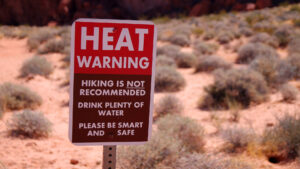This story was originally published by Grist. Sign up for Grist’s weekly newsletter here.
By Sachi Kitajima Mulkey, Grist
From coast to coast, heat has enveloped the United States for nearly a week, blushing weather maps with shades of red. On July Fourth, roughly half of all Americans were under extreme heat alerts. The trend continued through the holiday and into the next week, shattering temperature records in cities across the United States.
On Wednesday, roughly 140 million Americans, over a third of the country, remained under active National Weather Service extreme heat advisories, watches and warnings. A heat risk map released by federal agencies showed that the worst of the conditions were along each coast, marked by swaths of color-coded severity. On the West Coast, states from Washington to Arizona were awash in deep burgundy — extreme risk. Along the East Coast, states from Maine to Florida were splotched with scarlet — major risk.
“There’s not a whole lot of relief in sight,” said Zach Taylor, a meteorologist at the National Weather Service. In fact, the heat on both coasts could stick around through mid to late July. “This is a very dangerous and serious situation that people should not take lightly.”

On Sunday, Las Vegas breached 120 degrees Fahrenheit, eclipsing the city’s 2017 record by 4 degrees. By Tuesday, roads were buckling in Washington D.C., as the city hit 110 degrees F, and daily record highs were set in Seattle and across the Pacific Northwest.
The Centers for Disease Control and Prevention’s Heat and Health Tracker reveals an increase in heat-related emergency room visits in the most intensely-hit areas. This time last year, similar temperatures took over 645 lives just in Arizona’s Maricopa County, home to Phoenix, where the thermostat hovered around 110 degrees F for a month.
These dangerous conditions are the continuation of climate trends, following more than a year of record-breaking temperatures. Worldwide, the last 13 months have been the hottest ever recorded, and the last 12 months have surpassed 1.5 degrees Celsius of warming above preindustrial temperatures – a foreboding climate milestone.
According to Taylor, these heat waves are especially notable in intensity and length — features connected to human-caused planetary warming. Studies have shown that climate change creates heat waves that are more intense, linger for longer and move slower.
Scorching temperatures are also fueling wildfires. When heat is paired with low humidity and high winds, small ignitions can quickly grow into infernos. As of July 10, the National Interagency Fire Center tracker showed there are 76 large active fires across the country, and almost all of them are in states under heat advisories. In Santa Barbara County, California, the Lake Fire has ballooned into a 28,000 acre blaze, the largest the state has seen this year. In Southern and Central Oregon, officials are ordering evacuation notices for multiple wildfires.
Cities are especially dangerous due to the urban heat island effect, in which buildings and roads trap and amplify heat. In Phoenix, a hundred degree day can turn the asphalt into a 160-degree F griddle, leaving those who touch it with life-threatening burns. As temperatures rise, urban conditions also become ripe for a chemical reaction that creates ground-level ozone pollution, which can cause asthma and respiratory problems. On Monday, New York State issued an air quality advisory after this pollutant was detected at harmful levels.
And health threats don’t go away with the sun. In addition to the record daily temperatures, Taylor says, stagnant air can cause lingering highs overnight. “That can be equally, if not more, impactful to the health and heat stress, because it doesn’t give the body an opportunity to cool off and recover at night.”
“Heat is an issue that is cumulative,” said Claudia Brown, a health scientist at the CDC’s National Center for Environmental Health. “So it’s not just necessarily a single hot day that leads to heat related illnesses, but really having consecutive high temperatures,” Studies have shown that the risk of death compounds with each consecutive day of heat, and raised nighttime temperatures make it even worse.
And not everybody is at equal risk. “People that are older or young children tend to be more vulnerable because their bodies don’t thermoregulate as effectively,” Brown said.
Other factors, like chronic health conditions and working outdoors, can exacerbate the odds and severity of heat illnesses, too. Because risks vary between neighborhoods, Brown recommends that those under heat advisories check the threat level in their specific ZIP code using the CDC’s online HeatRisk tool.
As temperatures are expected to simmer into the coming weeks, many local governments — such as Maricopa County in Arizona and Multnomah County in Oregon — are providing cooling centers for people who may be unhoused or lack access to air conditioning. Despite the busy summer season, the National Park Service also recommends that hikers visiting heat-besieged landmarks, like Death Valley and the Grand Canyon, rethink their plans.
This article originally appeared in Grist at https://grist.org/extreme-heat/dangerous-heat-another-record-summer/.
Grist is a nonprofit, independent media organization dedicated to telling stories of climate solutions and a just future. Learn more at Grist.org.
If you are interested in submitting an opinion piece to The Invading Sea, email Editor Nathan Crabbe at ncrabbe@fau.edu. Sign up for The Invading Sea newsletter by visiting here. To learn more about the urban heat island effect, watch the video below.



